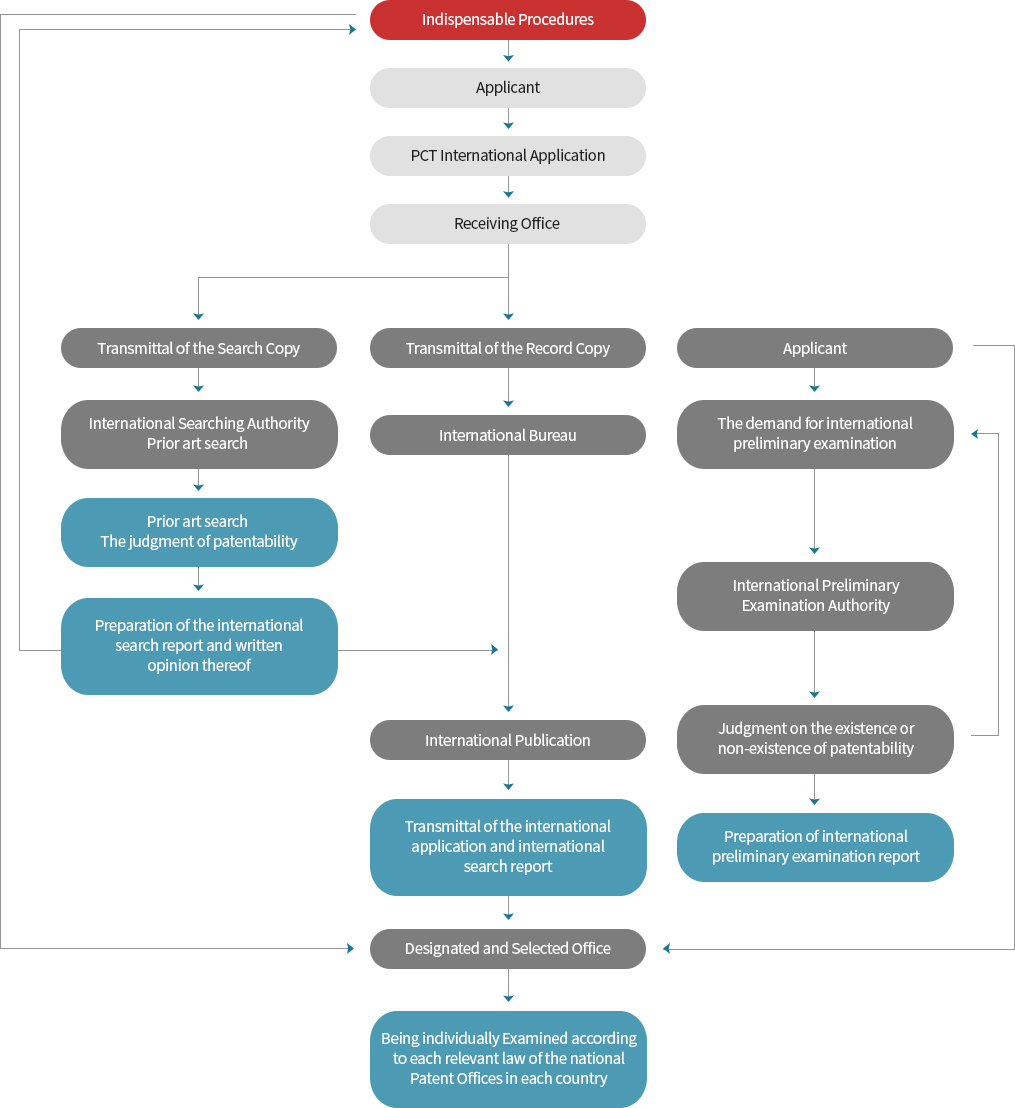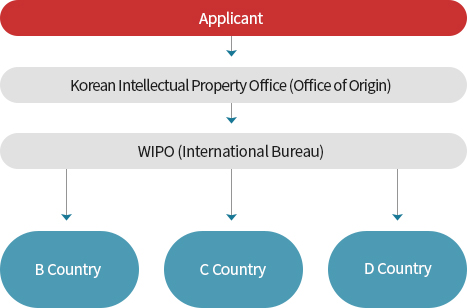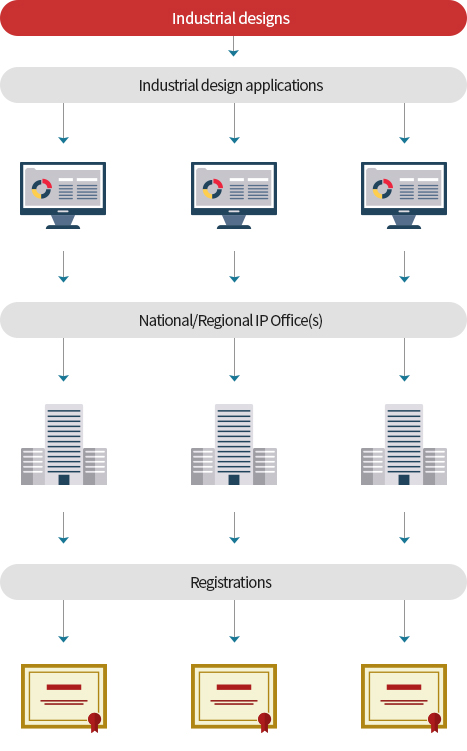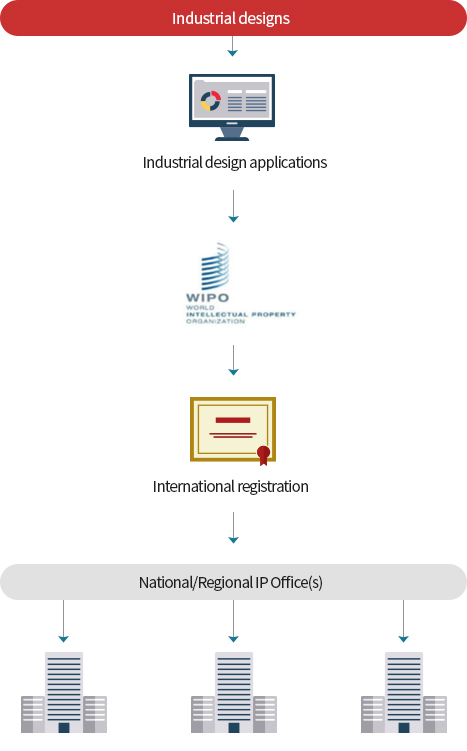The international application system is a system in which an applicant may submit a PCT international application to the Patent Office (Receiving Office) of which the applicant is a national or resident, and within a predetermined period from the filing date, such an application may be filed as a national-phase application with the national Patent Offices of countries (designated or selected countries) where the applicant wants to obtain a patent. The filing date of the PCT international application shall be accepted as the filing date of the designated countries.
However, in a case where a PCT international application is filed with the claim of priority based on a prior application, such an application must be filed within 12 months from the filing date of the prior application so that the priority can be accepted.
International Application
When an applicant submits three copies of application documents prepared in the Korean language, English language or Japanese language to the Receiving Office, formality examination is conducted (necessary documents are the same as those of a domestic application).
The designation of countries: There is an effect to designate all PCT member countries entered into the Patent Cooperation Treaty at the time of filing an international application (However, an intention whether or not to designate Germany, Japan or Korea can be separately indicated.)
International Publication by WIPO: In general, the WIPO publishes an international application when 18 months from the priority date has passed, and if an applicant demands to publish his or her international application to the WIPO, the international application may be published early.
Progress of Examination
Each designated Office which receives a translation submitted by an applicant shall examine the application corresponding to the translation according to each law of the designated countries and decide whether or not to grant a patent.
The PCT international application system adopts the reach doctrine in which the date when a document reaches the WIPO is actually deemed the receipt date. It is possible to delete any designated country, but impossible to add it.

| Division | PCT International Application | Direct Application in Foreign Countries (route under the Paris Convention) |
|---|---|---|
| Approval of a filing date | Effect of directly filing an application in many PCT member countries by filing one PCT international application | Direct application in each individual country |
| Enhancing of a possibility of being registered as a patent | Pre-judgment on patentability through international search and preliminary examination procedures before the entry into designated countries | Judgment on patentability according to patent requirements prescribed in each law of individual countries |
| Preparation of an application document | the application need only be submitted in a single language(selected from among Korean, English, & Japanese) | the application must be prepared in multiple languages as are approved by each individual country |
| Prevention of reckless foreign applications | An applicant may decide whether or not to proceed with a national phase procedure by reviewing the possibility of being registered as a patent and investigating marketability in designated countries before the entry in the designate countries (within 30 months from the priority date) | Before filing a foreign application in each individual country, an applicant should directly carry out prior art searches and should judge a possibility of being registered as a patent |
| Reduction in Fees | Reduction in some fees in each national country upon the entry into a national phase based on a PCT international application | Reduction in fees is based on each law of individual countries |
| Division | PCT International Application | Direct Application in foreign countries (filing route under the Paris Convention) |
|---|---|---|
| Fee for International Application | An additional fee for a PCT international application is incurred | Only an application fee for each individual country is incurred |
| Double examination procedure | After receiving an international search report and an international preliminary examination report and filing a patent application for entry into a national stage, the patent application should be newly examined in each designated country | Only an examination procedure of each individual country is performed |
| Severity of time limits | In the international application step, since the rules to observe time limits PCT are strictly prescribed, a disadvantage can be generated when the time limits are exceeded | An obligation to follow the rules of time limits after filing of the application in each individual country is the same as that of the PCT channel |

Preparing an Application in one language of English, French and Spanish languages and filing one application
※ The Madrid system has been operated by the Madrid Agreement and the Madrid Protocol, and administrative work for this has been conducted in International Bureau of the WIPO (World Intellectual Property Organization).
1) Basic Requirements
A mark targeted for an international application must be completely identical to a mark which is valid in Korea, and the scope of designated goods (service) must be identical to or within that of the mark which is valid in Korea.
2) Applicant
An applicant must be a citizen of the Republic of Korea or a foreigner that has an address in the Republic of Korea who has his or her own application for trademark registration or registered trademark. In a case where two or more persons jointly file an international application, all of them must meet the requirement.
3) Language of International Application
The language of an international application is determined by relevant Office of Origin among English, French or Spanish languages, and Korea selects the English language.
4) Duration of International Registration
International registration is effective for 10 years from the registration date, and it is possible to renew it every ten years. By filing one request for renewal with the International Bureau, namely, one single procedure step, registration for the renewal can be recorded in each designated country.
5) Examination by Designated Office
Unless each Designated Office which receives a Notice of designation sends a Notification of refusal of the protection of a mark within a certain period (one year or 18 months) to the International Bureau, each relevant Designated Office must protect the mark as being registered in the designated countries.
1) This system provides the opportunity to ensure the protection of marks in several countries by filing one international application with the Office of Origin.
2) Although procedures such as the renewal of duration, the assignment of ownership, a request for change of name and the like are performed in only the International Bureau, it is not needed to separately perform the procedures in each country, and it has been deemed satisfactory to perform them in each country designated by an applicant.
3) It is possible to additionally designate goods as well as any country which was not designated at the time of filing the original international application through the subsequent designation procedure within the scope of international registration even in the case of limiting and designating the goods (services) regarding a specific country.
1) A case in which a basic application (registration) is rejected, abandoned, invalidated or the like before the period of five years from the international registration date has expired (including a case in which the effect of international registration is entirely or partially cancelled due to the concentrated attack by a third party, and a case in which a basic applicant voluntarily conducts an amendment to reduce claims or the effect of international registration is entirely or partially cancelled due to the non-renewal of duration by a basic registrant)
2) International registration regarding all or part of designated goods (services) of an international application is cancelled, and as a result, the international registration also loses effect within the cancelled scope of the international registration in all the designated countries.
When a basic application (registration) which is pending or registered in the Office of Origin is cancelled within a certain period, international registration in the relevant International Register is cancelled. Thus, an international application which is being examined or is registered through examination in each designated country loses effect. Accordingly, if an interested person cancels a basic application (registration) of the Office of Origin by a concentrated attack, he or she may invalidate the mark registered in each designated country.
You may want to register your designs in new markets to obtain protection abroad. The Hague System for the International Registration of Industrial Designs provides a centralized registration system where you can e-file up to 100 designs and target over 62 territories in one single application that you could use to claim priority on in further filings.
The Republic of Korea joined the 1999 (Geneva) Act of the Hague Agreement in March 2014. Any individual or business in the Republic of Korea can now file an international design application under the Hague System either through KIPO or directly with WIPO.



※ If registration is desired in only one country, direct filing may be cost effective.
From "2015 KIPO-WIPO Hague Seminar"